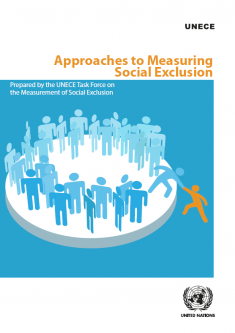Social exclusion is measured and defined in a range of ways. While many countries measure some aspects of social exclusion, few surveys or statistical methods are specifically designed for this. This publication presents approaches and practices in measuring social exclusion.
The introductory Chapter 1 lays down the motivation behind the work and what is meant by social exclusion.
Chapter 2 focuses on concepts of exclusion or inclusion, equalities and well-being, acknowledging that these ideas are defined differently in the context of individual societies and may change over time.
Chapter 3 considers why we may want to measure inclusion or exclusion, equalities and well-being, or leaving no one behind, using specific policy examples that have motivated measurement.
Chapter 4 focuses on different approaches to measuring these concepts, looking at what tends to be measured most often and highlighting variation across contexts. It includes examples of different measurement frameworks that have been used to measure social exclusion, social inclusion, multiple deprivations or multiple inequalities, and well-being. Finally, the chapter considers how the measurement of social exclusion may contribute to the fulfilment of the ‘leave no one behind’ pledge of the 2030 Agenda for Sustainable Development.
Chapter 5 looks at how to be as inclusive as possible in measurement and presents examples of how to include the marginalised groups who are frequently left out of statistical measurement.
Chapter 6 focuses on how findings from social exclusion may be presented, highlighting different levels of analysis used in the measurement of these concepts and different approaches to analysing the findings. This may depend on both pragmatic considerations, such as the comprehensiveness of data available and data sources, as well as considerations of how to present progress towards specific policy goals in clear and accessible ways.
Chapter 7 considers where countries participating in this work are in relation to the measurement of social exclusion, including data currently available in different countries, and how inclusive, granular and comprehensive it is. Based on that assessment, recommendations are made for the way forward.
Finally, Chapter 8 presents an overview of the issues that would be a priority in the future work on measuring social exclusion.
The publication mainly targets national statistical authorities and provides useful information for policymakers, researchers and others interested in the measurement of poverty and social exclusion.
